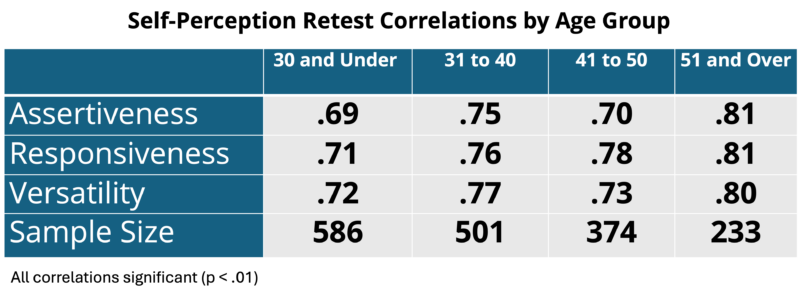One of the most common questions we get is whether SOCIAL STYLE can change over time. As a person grows older, gains more experience, and matures, can their Style evolve? The short answer is “yes” this can happen, and new research sheds light on this.
Previous research has shown that Style stayed relatively consistent over time, but we also knew this was never an absolute; some people did change Style when they re-profiled. There are some common reasons for this: people change jobs and their behavior changes subtly, especially if they’re new people managers; people’s rater group changes, and this can affect perceptions of behavior because the person may have different roles in different teams; and sometimes major life changes can lead to behavior changes.
While these things are always possible, our latest research shows that the stability of Style differs across age groups. We studied people who profiled more than once over time, an analysis called retest reliability. We correlated results on each scale (Assertiveness, Responsiveness, and Versatility) across the two time periods. Higher correlations mean higher consistency from Time 1 to Time 2 (i.e., a person is more likely to profile as the same Style).
We discovered that people aged 30 and under have the lowest retest reliability of any age group, while people 51 and older have the highest retest reliability. Overall, reliability increased as age increased (with slight decreases in the “41 to 50” group on Assertiveness and Versatility). You can see the correlations broken down by age group in the table below. (These results are based on self-perception data. We could not run this analysis on multi-rater data due to low sample sizes across the different age categories, which makes results unstable.)

Style and Versatility behaviors stabilize as people grow older. This is important because it confirms that younger adults who are new to the working world are learning and maturing as they go along, which can be seen in their behavior. So, noticing some Style change is normal, especially for younger people.
While this may seem contrary to what we all learned growing up, the newest research in personality psychology corroborates TRACOM’s findings. For decades students in introductory psychology classes (along with many advanced personality courses) were taught that personality is stable by adolescence. This is not exactly true. The consensus of recent research shows that personality does evolve over time, in a very similar way that Style can change.[i] Personality traits are most likely to change before age 30, becoming most stable between ages 50 and 60, then more likely to change again after age 70.
So, if you’re facilitating a Style program, you can now confidently tell your participants that some Style change is normal, and it’s most likely to happen for younger people. Just as personality can change, so can behavior. Just remember that change is likely to be subtle, not dramatic.
To read about the full research study, download our most recent technical report.
[i] Roberts, B. et al. (2019). The policy relevance of personality traits. American Psychologist, 74(9), 1056-1067.

 New Horizons
New Horizons
 Project Management Academy
Project Management Academy
 Six Sigma Online
Six Sigma Online
 TCM Security
TCM Security
 TRACOM
TRACOM
 Velopi
Velopi
 Watermark Learning
Watermark Learning
 Login
Login

